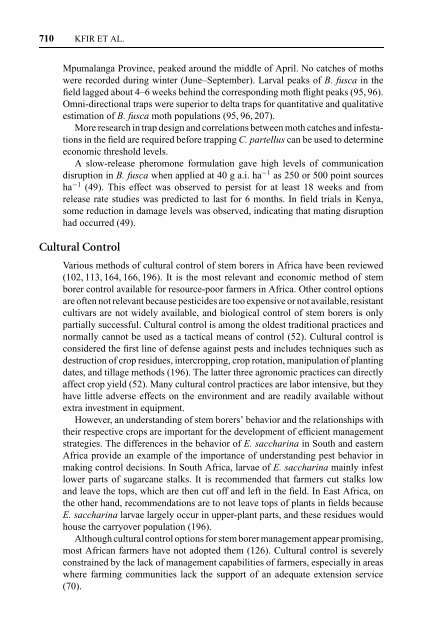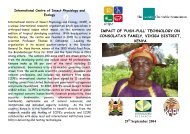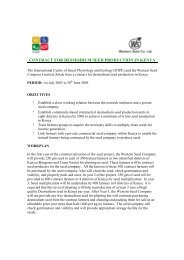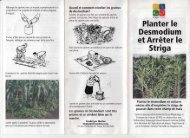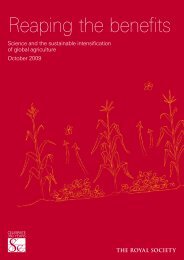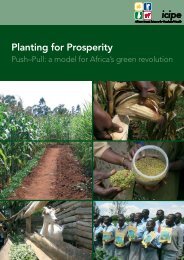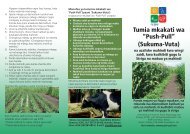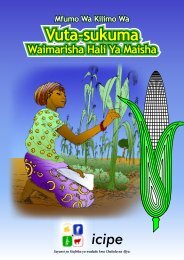Biology and management of economically important ... - Push-Pull
Biology and management of economically important ... - Push-Pull
Biology and management of economically important ... - Push-Pull
Create successful ePaper yourself
Turn your PDF publications into a flip-book with our unique Google optimized e-Paper software.
710 KFIR ET AL.<br />
Mpumalanga Province, peaked around the middle <strong>of</strong> April. No catches <strong>of</strong> moths<br />
were recorded during winter (June–September). Larval peaks <strong>of</strong> B. fusca in the<br />
field lagged about 4–6 weeks behind the corresponding moth flight peaks (95, 96).<br />
Omni-directional traps were superior to delta traps for quantitative <strong>and</strong> qualitative<br />
estimation <strong>of</strong> B. fusca moth populations (95, 96, 207).<br />
More research in trap design <strong>and</strong> correlations between moth catches <strong>and</strong> infestations<br />
in the field are required before trapping C. partellus can be used to determine<br />
economic threshold levels.<br />
A slow-release pheromone formulation gave high levels <strong>of</strong> communication<br />
disruption in B. fusca when applied at 40 g a.i. ha −1 as 250 or 500 point sources<br />
ha −1 (49). This effect was observed to persist for at least 18 weeks <strong>and</strong> from<br />
release rate studies was predicted to last for 6 months. In field trials in Kenya,<br />
some reduction in damage levels was observed, indicating that mating disruption<br />
had occurred (49).<br />
Cultural Control<br />
Various methods <strong>of</strong> cultural control <strong>of</strong> stem borers in Africa have been reviewed<br />
(102, 113, 164, 166, 196). It is the most relevant <strong>and</strong> economic method <strong>of</strong> stem<br />
borer control available for resource-poor farmers in Africa. Other control options<br />
are <strong>of</strong>ten not relevant because pesticides are too expensive or not available, resistant<br />
cultivars are not widely available, <strong>and</strong> biological control <strong>of</strong> stem borers is only<br />
partially successful. Cultural control is among the oldest traditional practices <strong>and</strong><br />
normally cannot be used as a tactical means <strong>of</strong> control (52). Cultural control is<br />
considered the first line <strong>of</strong> defense against pests <strong>and</strong> includes techniques such as<br />
destruction <strong>of</strong> crop residues, intercropping, crop rotation, manipulation <strong>of</strong> planting<br />
dates, <strong>and</strong> tillage methods (196). The latter three agronomic practices can directly<br />
affect crop yield (52). Many cultural control practices are labor intensive, but they<br />
have little adverse effects on the environment <strong>and</strong> are readily available without<br />
extra investment in equipment.<br />
However, an underst<strong>and</strong>ing <strong>of</strong> stem borers’ behavior <strong>and</strong> the relationships with<br />
their respective crops are <strong>important</strong> for the development <strong>of</strong> efficient <strong>management</strong><br />
strategies. The differences in the behavior <strong>of</strong> E. saccharina in South <strong>and</strong> eastern<br />
Africa provide an example <strong>of</strong> the importance <strong>of</strong> underst<strong>and</strong>ing pest behavior in<br />
making control decisions. In South Africa, larvae <strong>of</strong> E. saccharina mainly infest<br />
lower parts <strong>of</strong> sugarcane stalks. It is recommended that farmers cut stalks low<br />
<strong>and</strong> leave the tops, which are then cut <strong>of</strong>f <strong>and</strong> left in the field. In East Africa, on<br />
the other h<strong>and</strong>, recommendations are to not leave tops <strong>of</strong> plants in fields because<br />
E. saccharina larvae largely occur in upper-plant parts, <strong>and</strong> these residues would<br />
house the carryover population (196).<br />
Although cultural control options for stem borer <strong>management</strong> appear promising,<br />
most African farmers have not adopted them (126). Cultural control is severely<br />
constrained by the lack <strong>of</strong> <strong>management</strong> capabilities <strong>of</strong> farmers, especially in areas<br />
where farming communities lack the support <strong>of</strong> an adequate extension service<br />
(70).


